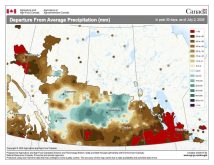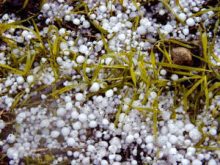Moderate to cooler than normal temperatures last week. Strong southerly winds on Wednesday caused soil blowing and drifting on soils with dry topsoil and poor crop residue.
Low to moderate rainfall amounts reported in most regions with the highest precipitation in the North West where some fields are excessively wet and will require days of good drying conditions before field operations resume.
Seeding is nearing completion in Manitoba with about 90 per cent of cultivated acres seeded. Many growers are already done. Seeding is lagging most in the North West and South West regions with 70 to 85 per cent completed respectively.
Read Also

Farmer-friendly nematodes: Tiny worms for big canola pest control
Not all nematodes are equal in farm fields. Beneficial species of the tiny soil-dwelling worms could one day help beat back damaging canola insect pests like diamondback moth on the Canadian Prairies.
Earliest planted cereals are in the 3 to 4 leaf stage and post emergence herbicide applications are going on as weather conditions allow. Canola, field peas, corn and also some soybeans are emerged.
Low insect pressure generally reported at this time on early emerging crops.
Hay and pasture fields are growing slow and need warmer temperatures to stimulate growth. Livestock water supplies are considered adequate.
Southwest Region
Rainfall over the past week has slowed down seeding operations in the Southwest. About 5 to 20 mm of rain has fallen over most of the region. The highest rain fall was recorded in Russell and the surrounding area. The areas in the Southwest corner received very little precipitation this week. Crops could benefit from some rainfall at this stage. Cool windy weather has slowed emergence in fields. There have been some reports of wind damage to seeded crop with the high winds from last week. Higher temperature will be very beneficial for most crops at this stage.
Winter wheat and fall rye continue to progress well with few fields at the early boot stage. Weed control applications have been completed in most winer cereal fields. Overall seeding is about 85 per cent complete with south of Highway #1 at 95 per cent while areas north of Highway #1 are 75 per cent done. Field peas are 100 per cent done seeding with very good emergence. Most of fields are at second to third node stage. Producers are planning for herbicide application. Cereal crops are about 90 per cent complete with only wetter fields and some silage or green feed acres to be planted. Some of the early seeded cereal crops are in the 3 to 4 leaf stage. Canola is about 75 per cent done seeding with early planted canola emerging. There are some reports of flea beetle feeding on canola however there is no major damage reported. Corn is about 80 per cent done planting with some early fields emerging. Sunflowers are emerging as well. Growers should be monitoring their sunflower fields for cutworms damage. Soybeans are about 80 per cent planted with some early fields just starting to emerge. Producers are rolling their fields. No major emergence problems reported so far. Some reports of the odd cutworm found in some fields but no major damage reported. Diamondback moth counts are very low in most of areas. There are reports of large infestations of tent caterpillars in poplar stands that are encroaching into yards and towns.
Salinity, compounded by dry weather conditions is causing delayed or failed emergence in some fields. Rainfall over the past week will stimulate forage growth on hay and pastures. Cool windy weather has slowed development of both pasture and hay crops. Most producers that were going to fertilize hay land have done so. Producers have been moving cattle to pasture throughout the southwest. Dugouts are full.
Northwest Region
Temperatures were cool through the week however seeding progressed for most of the region until rain mid-week. halted operations. Rainfall amounts varied from 15 to 25 mm throughout the region; The Pas area received over 35 mm. Soil moisture is generally adequate throughout the region with the exception of those areas that received higher rainfall amounts where it is considered excessive. Fields in the northern part of the region are inundated and will need extremely good drying conditions to allow field operations to take place.
Most of the region made progress with seeding. Overall seeding in the Northwest Region is estimated to be 70 per cent complete. The exceptions are The Pas and Lenswood/Birch River areas where inundated fields are curtailing field operations. Approximately 90 per cent of the wheat crop has been seeded and about 75 per cent of it is emerging. Emergence has been uniform. 50 to 60 per cent of the canola crop is seeded with emergence varying from 15 to 50 per cent. There was some frost in the Roblin area, but it has not caused significant damage. Good progress has been made on seeding of soybeans, however recent rainfall is causing some producers to rethink their seeding plans as seeding deadlines approach. Most acres of field peas are seeded and emerging uniformly. Winter cereals overwintered in good condition and are growing well. Drying weather conditions are needed throughout the region.
Forage growth still remains slow due to cool temperatures. Recent rainfall combined with this week’s forecasted warmer temperatures should further stimulate forage growth. Cattle are being hauled out to pasture but supplemental feed is required. Rain has halted all field operations including seeding of annual forages for greenfeed and silage.
Central Region
Weather conditions were favourable for seeding operations to progress with the majority of the crop seeded in most areas. Seeding is considered to be 95 to 100 per cent completed in the region. The St-Claude area is lagging behind for seeding progress with 50 to 60 per cent complete due to wetter soil conditions. Dry beans are almost all planted in the region with about 90 per cent in the ground. The region received some rainfall this past week, with amounts received ranging from 5 to 15 mm. Dry topsoil conditions prevail in lighter textured soils in the southwest part of the region and germination is impacted as a result. Strong southerly winds on Wednesday caused soil blowing on fields with poor crop residue cover.
A few fields of canola were reseeded from last week’s frost that impacted the western side of the region. Most emerged frost sensitive crops survived the sub-zero temperatures.
The recent rains have been beneficial as uneven germination was seen in fields with poor seedbed conditions.
The majority of cereals are emerged and growing well. Most cereal crops are in the 3 to 4 leaf stage.
Canola acres are considered all seeded at this time. Slow emergence and growth due to cooler temperatures as well as dry soils has allowed for flea beetle injury to occur. Insecticide applications are being made to headlands, and in a few cases, entire fields. Canola fields are in the cotyledon to 2 leaf stage in eastern areas where the crop has been in the ground the longest.
The field peas are to emerging well, as is corn. Corn fields are in the 1 to 2 leaf stage and growing slowly due to the cooler temperatures. Sunflowers and flax are emerging. Soybean planting is considered complete. Some soybean fields are starting to emerge.
Winterkill has been a concern in some winter wheat and perennial ryegrass fields in eastern parts of the region, with the majority of acres re-seeded. Fields in western areas with good winter survival are growing and tillering well; stem elongation is evident and fall rye fields will head out very soon.
Post-seed and pre-emergent herbicide applications and now post-emergent applications are a challenge due to windy conditions. Some are having a hard time keeping up to pre emergence spraying. The rain also delayed spraying progress. Post-emergence applications have begun in the most advanced cereals, with some early spraying for wild oat control; pressure is high in some fields. There is a lot of both broadleaf and grass weed pressure in many fields, especially where early application attempts were thwarted by adverse weather conditions.
Monitoring of diamondback moth in lure traps is ongoing and counts have been low to date.
Pasture conditions are rated as fair; but range from poor to good. Excess moisture is still a concern for some pastures and hay fields; others need a good rain. Forage growth in pasture and hay fields is progressing but slow due to moderate to cooler temperatures. Alfalfa in the northwest part of the region has suffered winterkill and fields have uneven growth. Pasture growth is not yet adequate to turn cattle out to graze. Livestock water supply is adequate.
Eastern Region
Small amounts of precipitation fell across the eastern region this past week with amounts ranging from 2 to 9 mm reported. The rain slowed the seeding progress but most welcomed the moisture as seed beds on the whole were on the dry side. Soil moisture conditions on cropland across the region were rated as adequate to a slightly inadequate. Soil moisture conditions of hay fields and pastures were rated at 10 per cent surplus, 80 per cent adequate to 10 per cent short.
Producers made good progress last week with almost all cultivated acres seeded. Across the region an assortment of crops are left to be seeded. In certain situations, dry seedbed conditions are still a concern. This is particularly true of crops seeded last week into dry seed beds including heavily worked fields or terminated hay stands that were direct seeded. These hay stands had suffered extensive winter damage and were terminated and direct seeded. Pre-emergent and post-emergent herbicide spraying goes on in several crop types. The most post-emergent applications have happened in cereals as early seeded fields are the most advanced. There has been some very early post-emergent spraying in soybeans where there are concerns about already present weed pressure. The number of field sprayers out on the land increased steadily as last week progressed. Overall most producers have noted that it has been a drier than normal as well as cooler than normal spring weather. As a result, crop emergence and crop development has been a bit slow. Most growers would like to see some rain to stimulate crop emergence and then return to normal weather conditions to advance crop emergence and development.
Across the region it is estimated that 90 to 95 per cent of spring seeding is complete. Spring wheat/other cereals as well as corn are done seeding and are at the 2 to 3 leaf stage. Canola is emerging and is in the cotyledon to one leaf stage. Soybeans and sunflowers are beginning to emerge and should all be up by the end of this week if the forecasted warmer temperatures are realized.
Livestock are slowly being moved to summer pastures with 50 per cent of the producers having their livestock out. Hog operations are having their manure storage facilities emptied onto hay fields. Hay fields and pasture are in good to fair condition with some alfalfa fields showing signs of winter kill. Some producers are terminating stands and replanting to another crop. Availability of livestock water was rated as adequate.
Interlake Region
Cool temperatures and much needed showers were experienced throughout the Interlake this past week. Most of the Interlake received between 3 to 7 mm of rain, except for Taylor’s Point west of Eriksdale which experienced a squall coming off Lake Manitoba and received 15 mm.
Seeding is near completed in the Interlake region with 2 to 5 per cent left to seed. Most cereals have emerged and are nearing the stage for spraying herbicides. Some spring seeded fields in the south Interlake have been sprayed for weeds, but little post-emergent spraying was done in the north Interlake. In the south Interlake, producers have been able to seed fields corner to corner and have had small showers to enhance crop emergence. Frost, cutworm and flea beetle damage has been minimal throughout the region so far.
Soybean development varies in the area from cotyledon to unifoliate stages. Warm season crops such as soybeans and corn are slow to emerge and grow. Forage seed fields continue to grow well and will be sprayed to control weeds in the weeks to come.
Diamond Back moth counts have been monitored for the last two weeks and low cumulated counts have been reported.
Scattered rains this past week have stimulated forage growth on hay fields and pastures . Alfalfa is in early to late vegetative stage and 15 to 36 cm tall Grasses are more advanced than the alfalfa in mixed stands due to the cool spring weather conditions.
Cattle are being hauled or walked out to native and tame pastures. Pastures are rated in fair to good condition. There is adequate water for livestock.


















